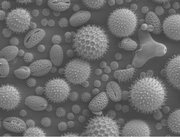Scanning electron microscope
|
|
LT-SEM_snow_crystal_magnification_series-3.jpg
The scanning electron microscope (SEM) is a type of electron microscope capable of producing high resolution images of a sample surface. Due to the manner in which the image is created, SEM images have a characteristic three-dimensional quality and are useful for judging the surface structure of the sample.
| Contents |
Scanning process
In a typical SEM configuration, electrons are thermionically emitted from a tungsten or lanthanum hexaboride LaB6 cathode filament towards an anode; alternatively electrons can be emitted via field emission (FE). The electron beam, which typically has an energy ranging from a few keV to 50 keV, is focused by two successive condenser lenses into a beam with a very fine spot size (~ 5nm). The beam then passes through the objective lens, where pairs of scanning coils deflect the beam either linearly or in a raster fashion over a rectangular area of the sample surface. As the primary electrons strike the surface they are inelastically scattered by atoms in the sample. Through these scattering events, the primary beam effectively spreads and fills a teardrop-shaped volume, known as the interaction volume, extending about 1µm to 5µm into the surface. Interactions in this region lead to the subsequent emission of electrons which are then detected to produce an image. X-rays, which are also produced by the interaction of electrons with the sample, may also be detected in an SEM equipped for Energy dispersive X-ray spectroscopy.
Detection of secondary electrons
The most common imaging mode monitors low energy (<50 eV) secondary electrons. Due to their low energy, these electrons must originate within a few tenths of a nanometer from the surface. The electrons are detected by a scintillator-photomultiplier device and the resulting signal used to modulate the intensity of a CRT that is rastered in conjunction with the raster-scanned primary beam. Because the secondary electrons come from the near surface region, the brightness of the signal depends on the surface area that is exposed to the primary beam. This surface area is relatively small for a flat surface, but increases for steep surfaces. Thus steep surface and edges (cliffs) tend to be brighter than flat surfaces resulting in images with good three-dimensional contrast. Using this technique, resolutions of the order of 5 nm are possible.
Detection of back-scattered electrons
In addition to the secondary electrons, backscattered electrons (essentially elastically scattered primary electrons) can also be detected. Backscattered electrons may be used to detect both topological and compositional detail, although due to their much higher energy (approximately the same as the primary beam) these electrons may be scattered from fairly deep within the sample. This results in less topological contrast than for the case of secondary electrons. However, the probability of backscattering is a weak function of atomic number, thus some contrast between areas with different chemical compositions can be observed especially when the average atomic number of the different regions is quite different.
Additionally, backscattered electrons cannot be "collected" with a positive bias on a standard Everhart-Thornley detector as is the case with secondary electrons. Use of a dedicated backscatter detector greatly improves the collection of backscatter electrons through improvement of the placement of the detector and by using a detector design that is only sensitive to the high-energy backscattered electrons. There are usually 2-10 times more backscattered electrons emitted from a sample than there are secondary electrons. The Everhart-Thornley detector has low geometric efficiency since it is located on one side of the sample and is highly directional in its collection. Placement of a backscatter detector above the sample in a "doughnut" type arrangement, with the electron beam passing through the hole of the doughnut, greatly increases the solid angle of collection and reduces the trajectory effects associated with backscattered electrons.
Resolution of the SEM
The spatial resolution of the SEM depends on the size of the electron spot which in turn depends on the magnetic electron-optical system which produces the scanning beam. The resolution is also limited by the size of the interaction volume, or the extent of material which interacts with the electron beam. The spot size and the interaction volume are both very large compared to the distances between atoms, so the resolution of the SEM is not high enough to image down to the atomic scale, as is possible in the transmission electron microscope (TEM). The SEM has compensating advantages, though, including the ability to image a comparatively large area of the specimen; the ability to image bulk materials (not just thin films or foils); and the variety of analytical modes available for measuring the composition and nature of the specimen. In general, SEM images are much more easy to interpret than TEM images, and many SEM images are actually beautiful, quite apart from their scientific value.
See also
External Links
- Tescan (http://www.tescan.com/an/index.html) Scanning Electron Microscope Manufacturer - Some Good Information and Nice Image Gallery
- Notes on the SEM (http://www.uga.edu/caur/semnote1.htm) Notes Covering All Aspects Of The SEM
Gallery of SEM images
The Wikipedia illustrates various topics with SEM images. Click on an image to see which pages use it.
Diatom0D.JPG
Ant_SEM.jpg
Krilleyekils.jpg
Krillommatkils.jpg
de:Rasterelektronenmikroskop fr:Microscopie électronique à balayage ja:走査型電子顕微鏡 pl:Elektronowy mikroskop skaningowy

